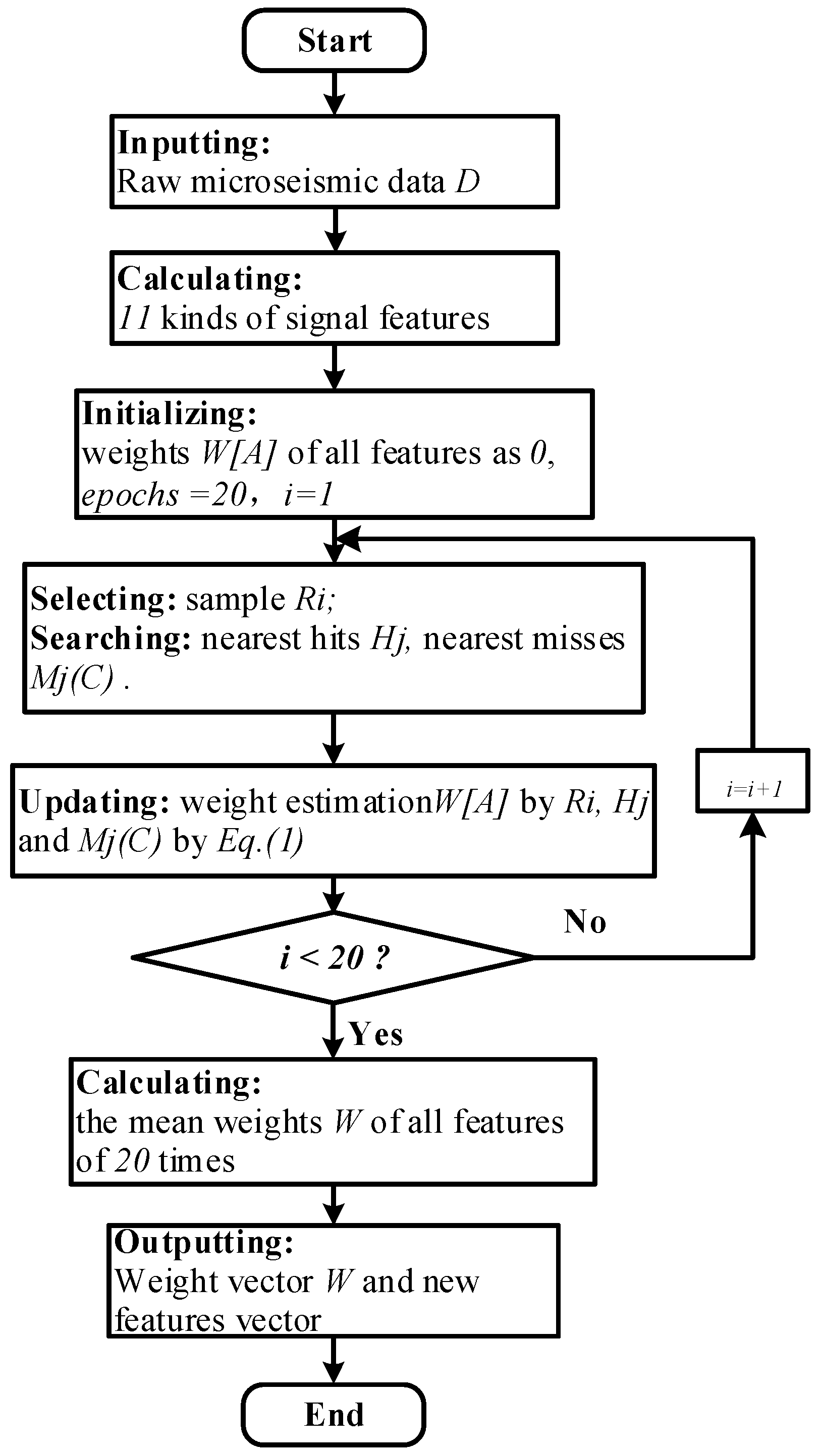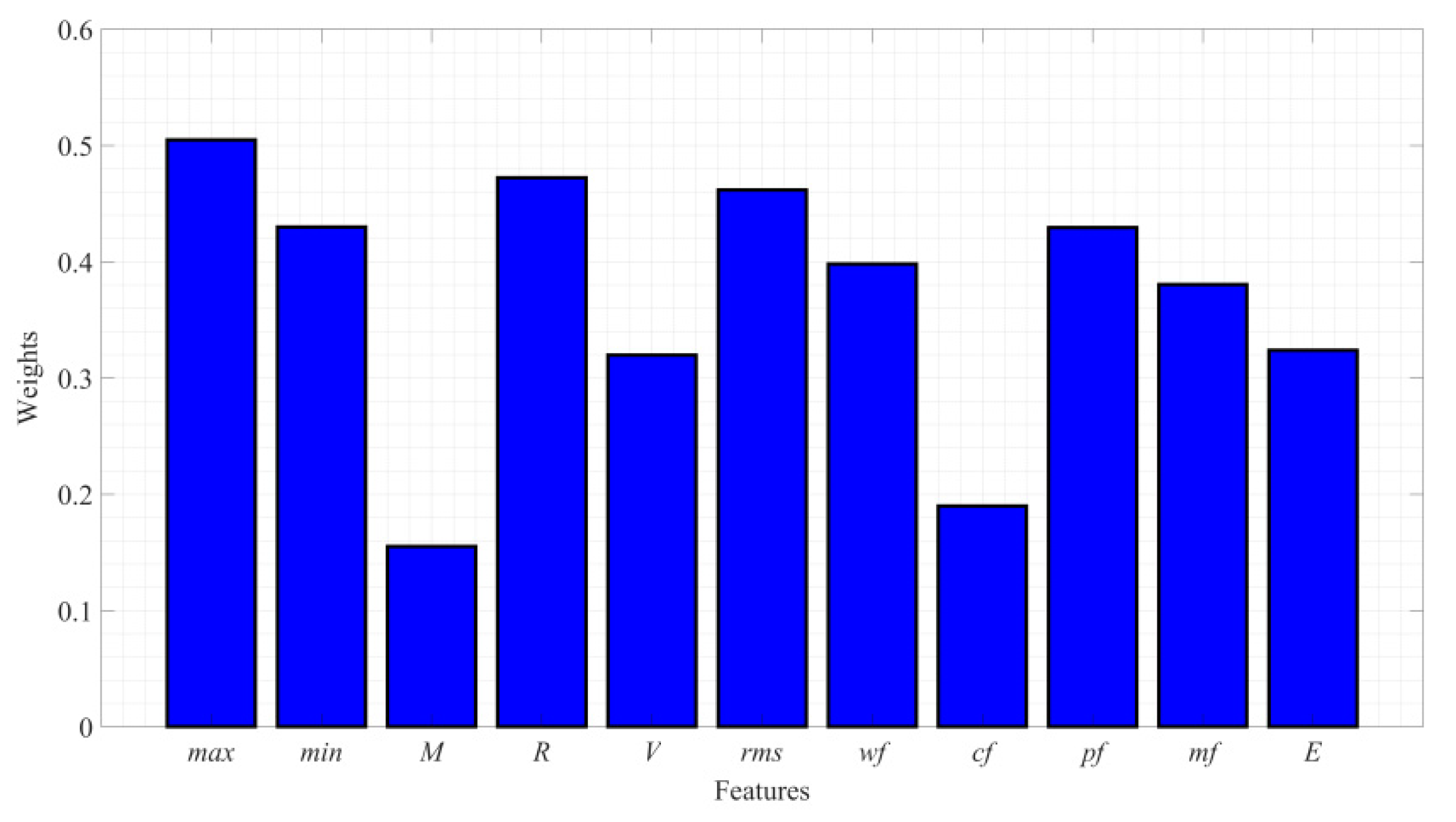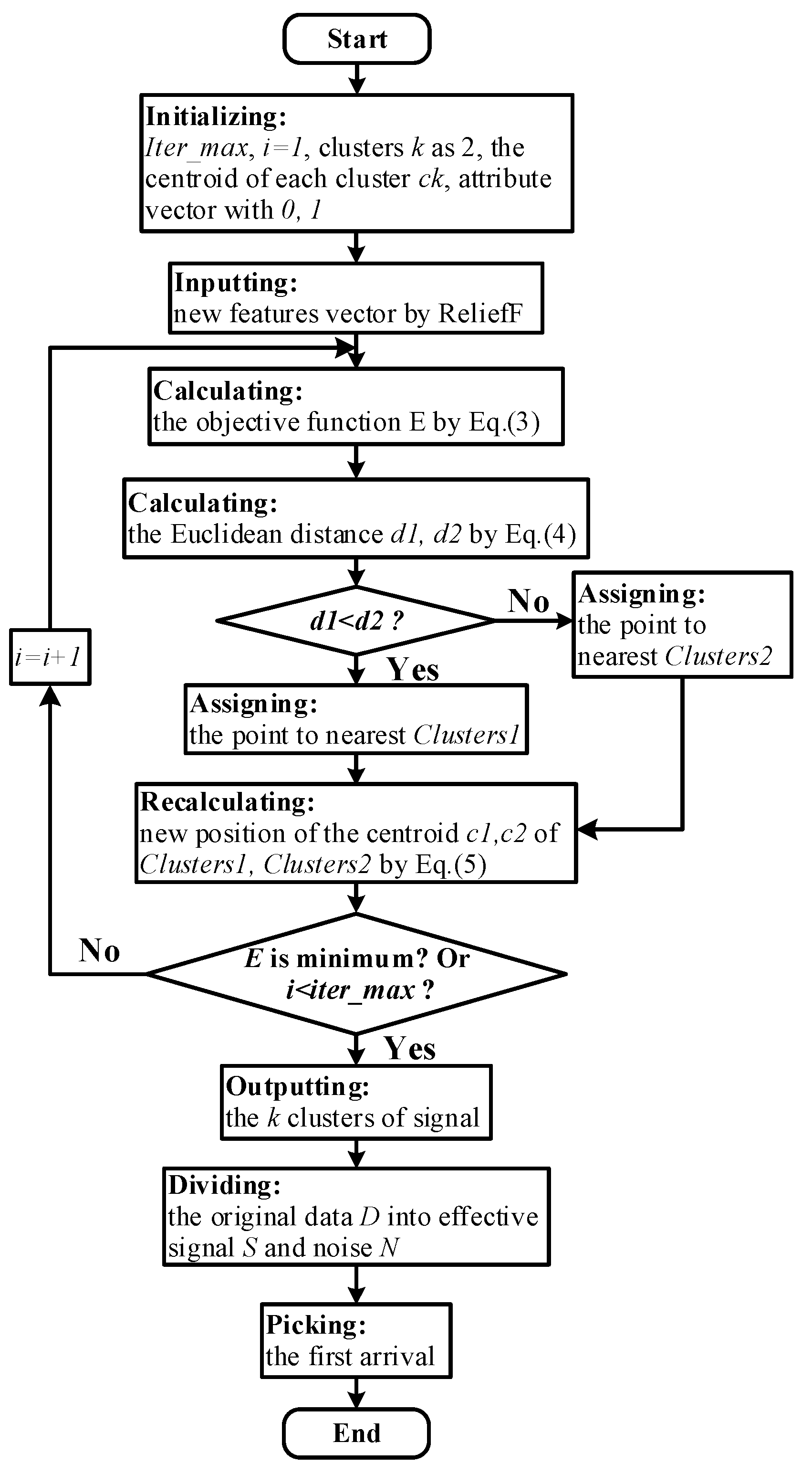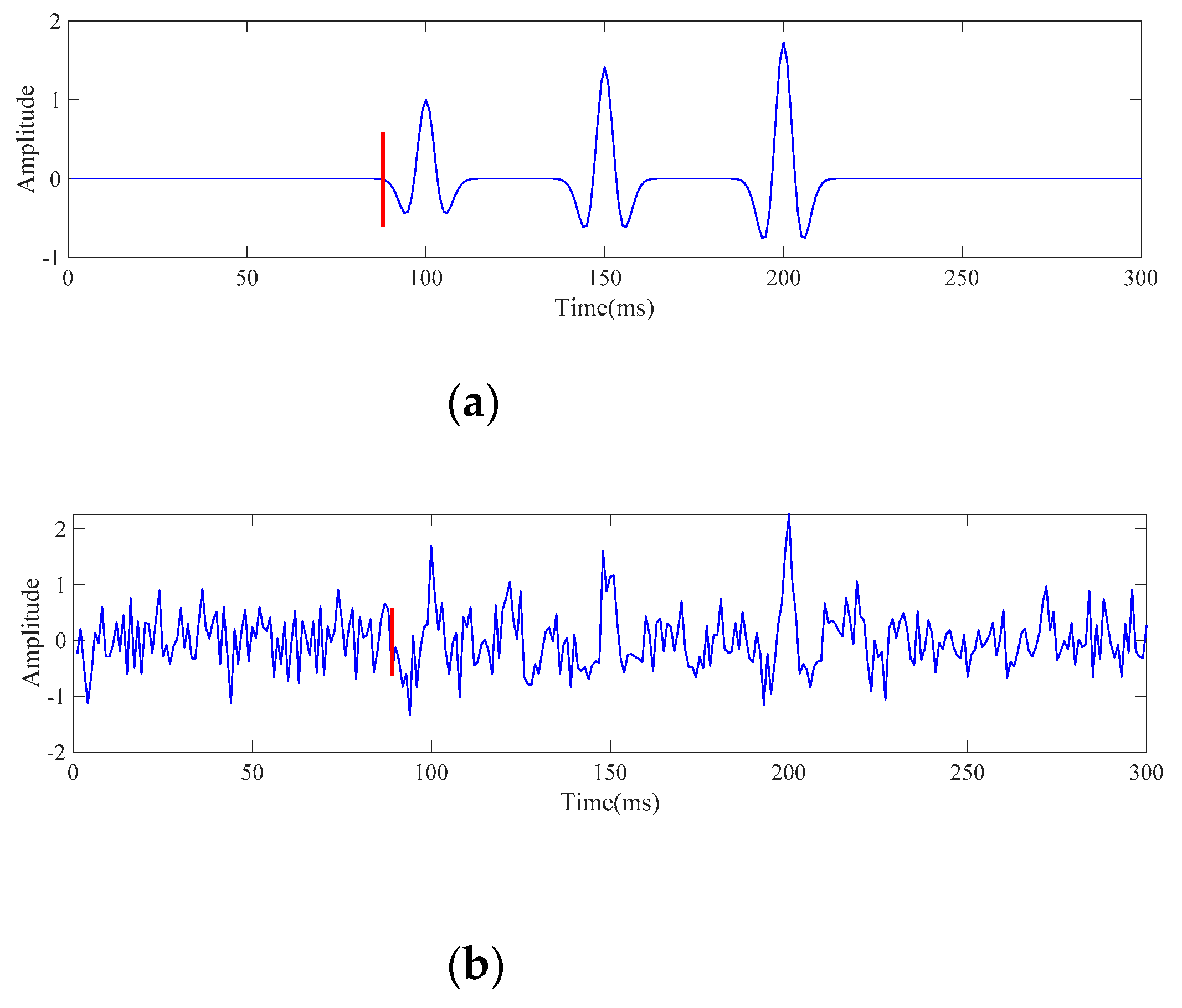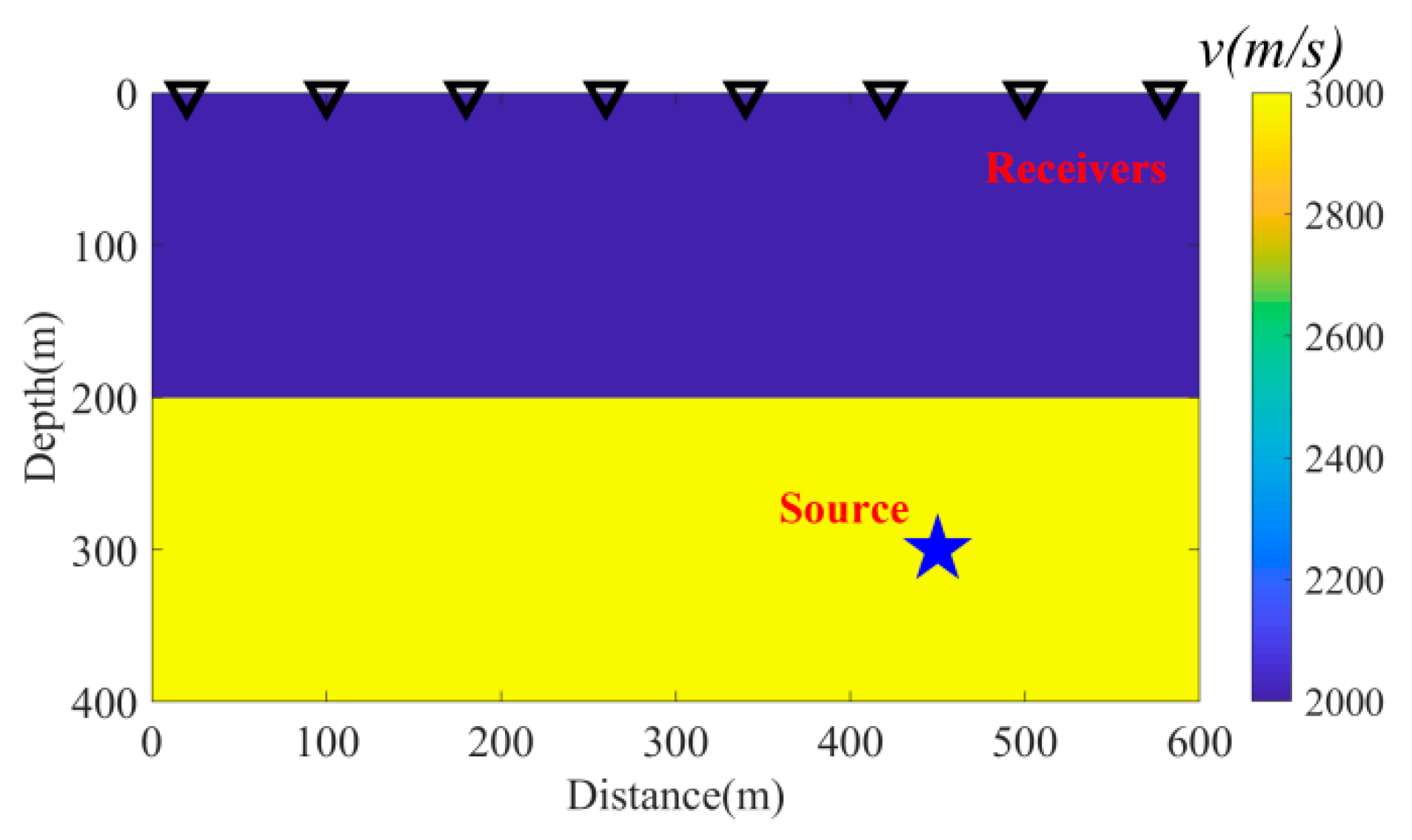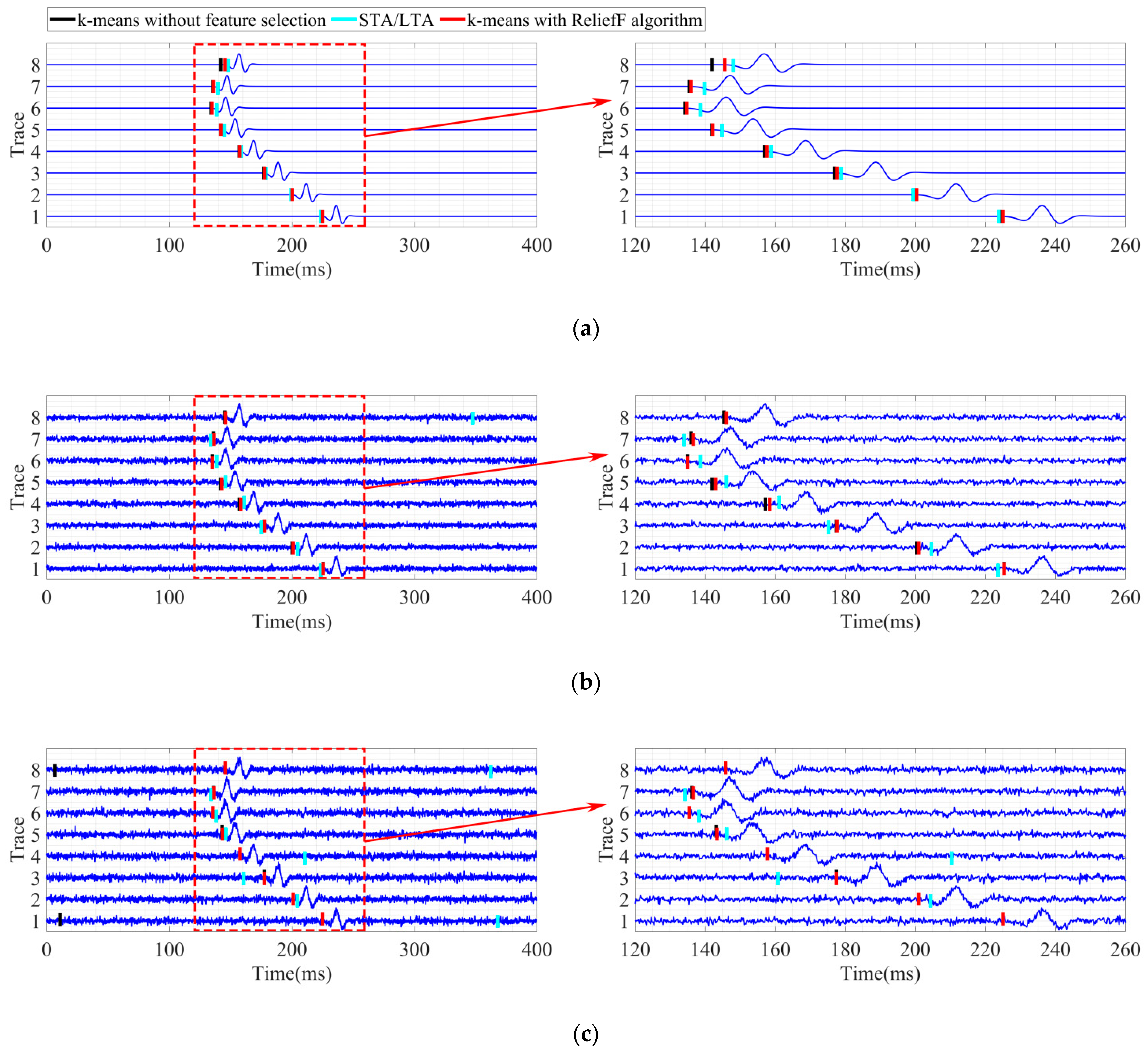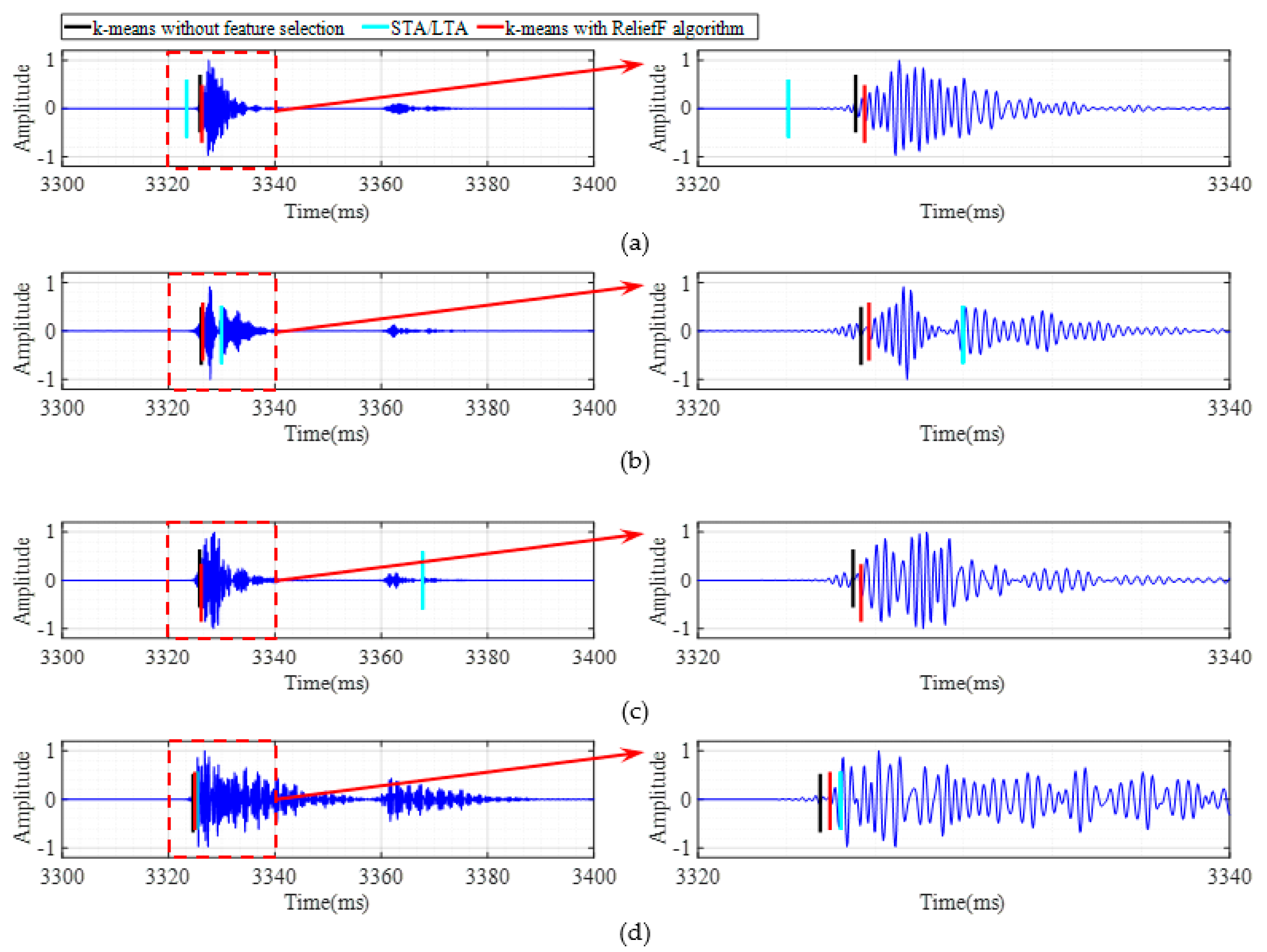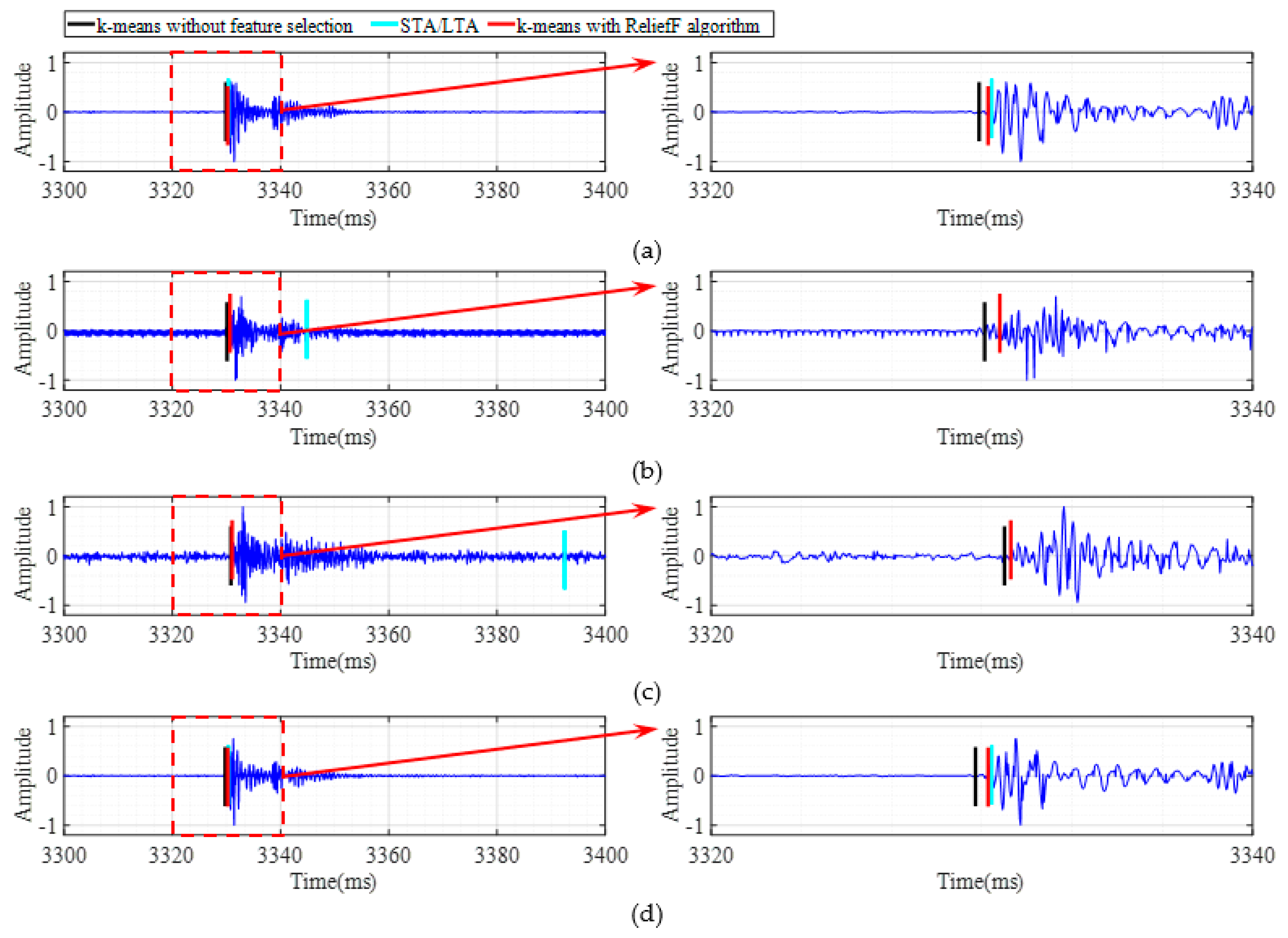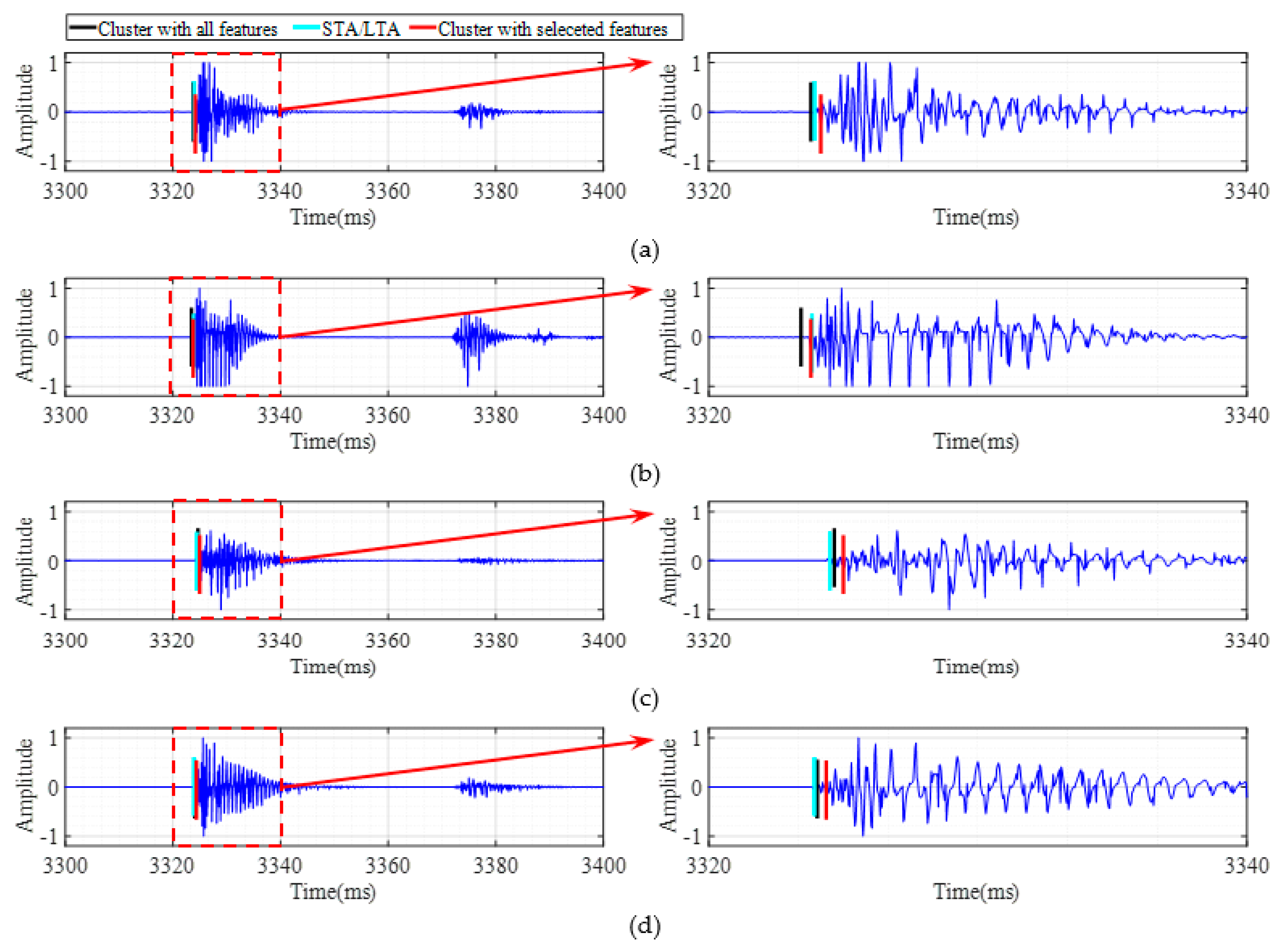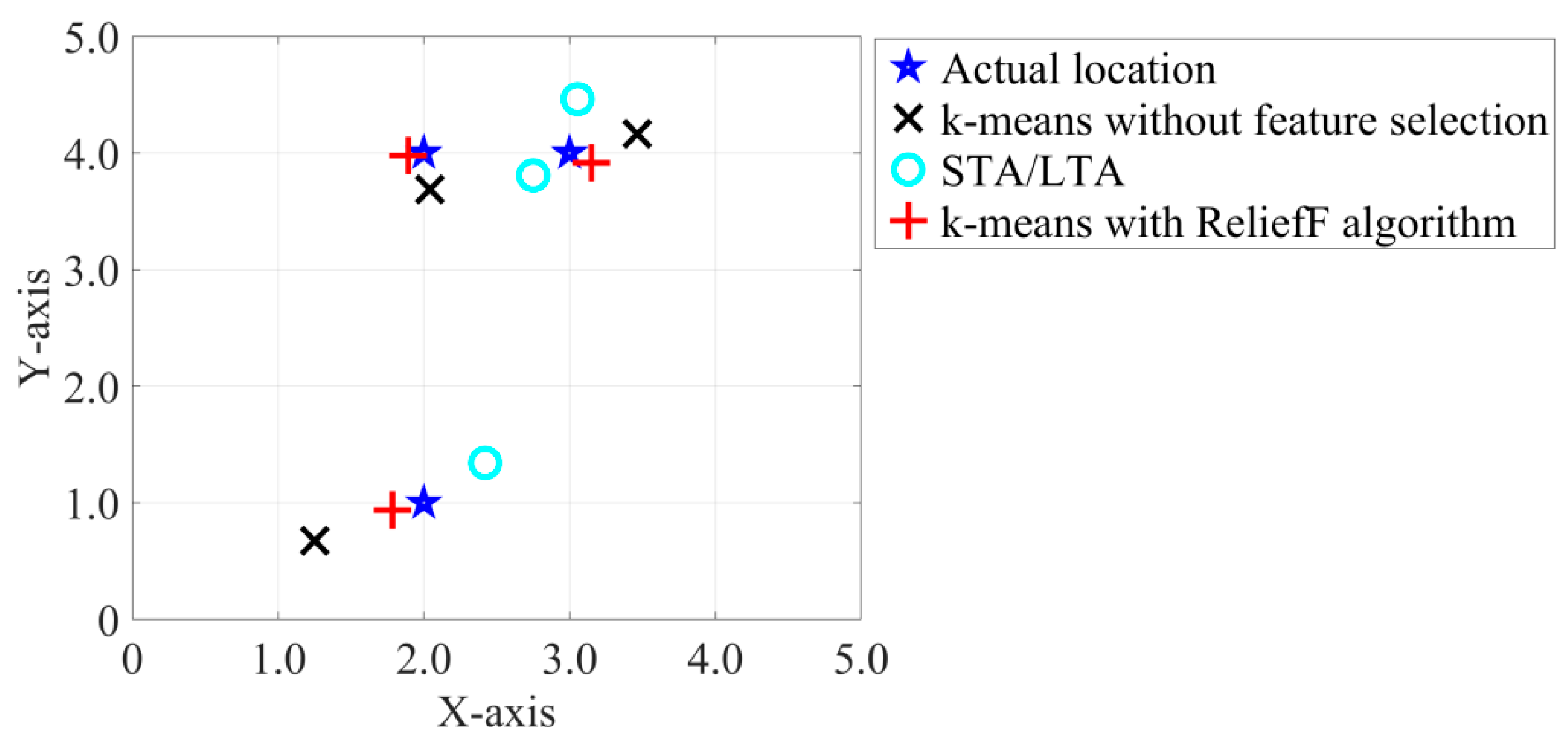1. Introduction
Microseismic monitoring is capable of offering the real-time characteristics of geo-structures by capturing the elastic waves released from rock fractures and realizing the localization of the microseismic events. This method has been widely applied in various fields, such as mining [
1,
2,
3], the construction of tunnels [
4,
5], slopes [
6,
7,
8], underground cavern explorations [
9], and hydraulic fracturing processes [
10,
11]. The quick and accurate picking of the first arrival for microseismic data is imperative for the data processing of microseismic monitoring [
12,
13]. However, due to environmental noise and other inevitable interferences, the signal-to-noise ratios (SNR) of the collected microseismic signals tend to be relatively low. Traditional methods cannot meet the high accuracy and efficiency requirements, which make the precise detection of the first arrival time very challenging [
14]. It has been found that small errors in the picking time tend to contribute to errors in the localization of the microseismic source, which hinders the assessments of geo-structure damage [
15]. The traditional method used to manually determine the first arrival information is labour intensive and time consuming. In addition, it cannot meet the high accuracy and efficiency requirements for the first arrival picking on microseismic signals, particularly under low SNR conditions [
16]. Therefore, the development of a fast, accurate, and automatic first arrival picking method from weak microseismic signals under low SNR conditions has received considerable interest in recent years [
17].
Based on the fact that the arrivals of primary waves generally produce relatively strong energy waveforms, several methods for the automatic determination of the first arrival time have been proposed. Traditional algorithms for picking microseismic arrival times include short-term average long-term average rations (STA/LTA) [
18] and the Akaike information criterion (AIC) [
19]. However, both the STA/LTA and AIC picking systems are sensitive to noise, and the picking results tend to be unsatisfactory under low SNR conditions. Time–frequency transform is an effective way to suppress noise and improve the performance of first arrival picking. Furthermore, Kalman filters [
20], median filters [
21], and other filters [
22,
23,
24] have been successfully utilized to remove the background noise in microseismic data. Wavelet transform [
25,
26], HHT transform [
27], Shearlet transform [
28], Radon transform [
29], and Intrinsic Time-Scale Decomposition [
30] methods have been adopted to preserve effective signal coefficients in transform domains in order to realize the removal of noise from microseismic data. Singular spectrum analysis [
31] achieved noise suppression by selecting N major components for the purpose of reconstructing sequences. In recent years, based on dictionary learning [
32] or improvements in traditional methods, researchers have successfully conducted studies to attenuate the noise in microseismic data. Nevertheless, the aforementioned de-noising methods tended to damage the useful signals during the noise suppression process. These methods were based on one or several features in the time domain, frequency domain, or other domains in order to remove noise and its components. These features were artificially defined by the amplitudes and frequencies of the signal waveforms. The above-mentioned methods have laid a certain theoretical foundation. However, in practical applications, they have important limitations, and a possibility exists for the decomposition of component waveform distortions.
Recently, machine learning methods have been successfully employed to detect events from time series data for various applications based on the fact that the microseismic data are mainly composed of useful signals and noise under actual conditions. The tasks of the first arrival picking of microseismic data can be treated as classification tasks which categorize the useful signals and noise signals from the raw microseismic data. At the present time, many existing studies have been completed regarding machine learning based on first arrival picking. The Neural Network Method is one of the mostly popular machine learning methods for arrival picking [
33,
34]. Gentili [
35] used a neural network-neural tree (referred to as IUANT2) to quickly and effectively determine P wave and S wave start times. Maity et al. (2014) [
36] proposed a new neural network model which utilized multiple derived attributes from data to automatically determine the arrival times of microseismic signals. Kaur et al. (2013) [
37] applied back-propagation neural networks (BPNN) to the automatically detect and identify local and regional seismic waves, and then determine p-wave arrival times. However, in real situations, generalized neural network models can only learn the simple features of data sets. The training of very complex models can be very inefficient and may easily lead to over-fitting issues. However, with the advent of the era of big data and the continuous improvements in computer hardware, deep learning has become an extremely powerful technology in the field of artificial intelligence. In recent years, several deep learning-based first arrival picking methods has been proposed. For example, Zhang et al. [
38] used an improved WGAN combined with a residual link nested U-Net network to achieve the “end-to-end” output of the microseismic input signals for the purpose of determining the first arrival times. Guo et al. [
39] designed a CNN model to classify each sample point of the waveform traces, and then combined a curve fitting method and an unsupervised clustering algorithm in order to determine arrival times. Chen et al. [
40] used a two-step method which combined CNN waveform classification and an unsupervised k-means clustering method to select arrival points. However, because the learning processes for the majority of the aforementioned studies were supervised, the performances of the first arrival picking are greatly dependent on the labelled training datasets. Due to their large sizes, labelled data sets are generally unavailable and unsupervised techniques are preferred.
Clustering is a branch of unsupervised methods which are intended to separate the data into groups of similar data points. It can automatically group samples into different clusters without the need for the high-quality labelled training of the datasets. In recent years, the development of clustering-based first arrival picking methods has received considerable interest. Zhu [
41] used a fuzzy c-means clustering (FCM) algorithm to pick up the initial time of the signal clusters as the data arrival times according to the similarities between the signals and the noise. Chen [
42] applied an unsupervised fuzzy clustering method to determine the arrival times of microseismic data. That type of method utilized three manually selected features (mean, power, and STA/LTA) as the feature vectors for the clustering. Ma [
43] adopted local linear embedding (LLE) and an improved particle swarm optimization (PSO) clustering algorithm to select the optimal clustering centres from low-dimensional data via a global search method, and used a k-means clustering algorithm to divide the low-dimensional data into noise and signals. Cano [
44] et al. proposed a conditional fuzzy c-means clustering to identify the time intervals of possible wave arrivals, and then used the Akaike Information Criterion (AIC) picker to pick up the arrival time. These progressive techniques have proven that, with properly selected features, clustering methods can be robust to noise and accurately integrate characteristics of different features in order to pick first arrival times. However, this study found that the majority of the aforementioned automatic methods relied on handcrafted features.
In order to tackle the aforementioned issues, a first arrival picking method for microseismic data based on a clustering method with automatic feature selection was introduced in this study. This was a two-step method which combined feature selection with clustering for first arrival time determinations. The feature selection based on the RelifF method was able to reduce the dimensions of the attribute spaces of the microseismic data and automatically identify the optimal features without the need for manually designed features. Once the effective feature vectors had been automatically selected, a clustering method was introduced which could easily determine the first arrivals from the microseismic data. The proposed method was first validated using synthetic data. The comparative study results indicated that the proposed method outperformed the classical STA/LTA and the k-means without feature selection. Furthermore, this study’s experimental test results demonstrated the feasibility of the proposed method using real microseismic data. Finally, the localizations of the microseismic source using the first arrival times obtained using different methods were compared in order to verify the superiority of the proposed method.
2. Experimental Methods
Due to the fact that microseismic data consists of effective signals and noise, the mission of the first arrival picking of the microseismic signals is similar to the classification of the effective signals and noise from the data. However, in the majority of practical situations, the SNRs of time-series microseismic signals are usually low, which makes the identification of effective signals very challenging. In the present study, in order to tackle this issue, it was critical to select informative features which could characterize the effective signals as feature vectors for the clustering processes. Therefore, a first arrival picking method for microseismic data based on clustering with automatic feature selection was introduced, which was defined as a k-means with ReliefF algorithm in this study. It was a two-step method consisting of two cascaded processes: feature selection and clustering for the first arrival time determination. The feature selection step was based on the ReliefF algorithm, which effectively reduced the dimensions of the attribute space of the microseismic data. It was able to automatically determine the optimal feature subset without the requirement of manually designed features. Once the effective feature vectors had been automatically selected, the first arrival times of the effective microseismic signals could be easily classified using the clustering algorithm. The combination of feature selection and first-come, first-served reduced the feature redundancy, and achieved a better performance than the classic k-means clustering method (referred to as k-means without feature selection in this study). The proposed method’s two steps will be elaborated in the following sections.
2.1. ReliefF Algorithm Based the Feature Selection for Microseismic Data
The Relief algorithm [
45] was initially limited to the classification of two types of data. However, the latter extended ReliefF algorithm [
46] has the ability to solve multi-class problems. The ReliefF algorithm is a feature weighting algorithm which assigns different weights to features according to the correlations of each feature and category. The larger the weight of the feature, the stronger the classification ability of the feature is. The ReliefF algorithm is used to estimate the weights of features according to how well their values can be distinguished among samples which are near to each other.
In this section, the multiple interrelated features for the microseismic data were pre-selected as data preparation for the ReliefF algorithm based on statistical knowledge. The ReliefF algorithm was then used to process the microseismic data and automatically select the feature vectors.
The selections of the feature vectors are vital for clustering-based microseismic first arrival picking. However, because the relevant attributes of the microseismic data are indefinite, manually selected features may not be suitable for microseismic signals with different SNR levels. In this study, the ReliefF algorithm was applied to process the microseismic data and automatically define the feature vectors, rather than using handcrafted features. Initially, eleven possible inter-related dimensional eigenvalues and dimensionless eigenvalues were preselected as features of the microseismic data based on statistical knowledge. These features included the maximum , minimum , mean , range , variance , root mean square , waveform factor , crest factor , pulse factor , margin factor , and power .
After the eleven possible features were calculated, the ReliefF algorithm was adopted to respectively estimate the weights of the various features using distinguishing instances. The ReliefF algorithm randomly selected a sample (
), and then searched for its nearest neighbours (
) from the same class, which were referred to as the nearest hits (
), as well as the nearest neighbours (
k) from each of the different classes, which were referred to as the nearest misses (
). The weight estimations (
) were updated by the
, nearest hit
, and nearest miss
values of all of the features. Therefore, if the
and
had different values according to
, the
would subtract the difference. In contrast, if the
and
had different values according to
, the
would add the difference. The weight estimations
were defined as follows:
where the contribution for each class of the misses was weighted with the prior probability of that class
, which was estimated from the training set. In this study, the
represented the prior probabilities for the same classes of
, and
represented the sum of the probabilities for the miss classes. The process was repeated twenty times. Function
was used to calculate the differences between the values of the feature
for the two samples
and
, and was defined as follows:
The specific implementation steps are shown in the flow chart detailed in
Figure 1.
Following the calculations for twenty epochs, the weights of the eleven preselected features were determined, as detailed in the blue histogram in
Figure 2. Among those features, the weights of the maximum
, range
, and root mean square
of the signal features were determined to be 0.58, 0.48, and 0.47, respectively, which accounted for the larger weights. At the same time, the weights of the minimum
and crest factor
were smaller, at 0.15 and 0.20, respectively. This indicated that the maximum
, range
, and root mean square
had the strongest classification abilities among the eleven features selected in this study. Therefore, the first three features with the largest weights selected by the ReliefF algorithm were utilized as the signal features for the k-means clustering in order to determine the first arrival times.
2.2. K-Means Clustering Method Based the Proposed First Arrival Picking
In this study, a k-means clustering method was adopted to process the selected feature vectors and to pick the first arrival times of the microseismic signals. The k-means clustering method is one of the most basic and well-studied unsupervised machine learning algorithms, which was developed by MacQueen in 1967. It is simple in operation, fast in calculation, and sizable to the amounts of datasets [
34,
37]. The k-means clustering method divides the entire dataset into
disjointed clusters. Each data point in the dataset is partitioned to the nearest cluster based on the Euclidean distance matrix. The k-means clustering method is mainly used to distinguish the effective signals
and noise
from the raw microseismic data
. In the current study,
was set, which corresponded to the effective signals and noise. For each datum, its attribute vector represents its coordinates in n-dimension space, where the datum is regarded as a point and
is the number of features.
The
objects were first randomly selected as the centroids
of the initial
clusters. Then, during each period, after initializing the clusters, the objective functions
were calculated. These are generally used to calculate the distances from the members of the cluster to each centroid on all of the clusters as the square error criterion functions. The objective function can be defined as:
where
and
represent the feature vectors of the
datum which has
features and the centroid of
cluster, respectively. In addition, the Euclidean distances between each point and the initial centroid of each cluster were calculated and defined as follows:
Therefore, by setting the distance between the point and the centroid
as
, and then assigning each point to the closest group (
or
), the new centroid
of each group could be recalculated and defined as follows:
The above-mentioned steps were iterative until the sum of the distances of the member objects to their respective centroids was the smallest over all of the clusters. In the current study, the attribute vector with 0, 1 distribution was obtained by the k-means clustering method. The length was consistent with the signals, and the separation of the signal
and noise
was successfully realized. Finally, the first change value was extracted as the first arrival time of the signals. The specific implementation steps are shown in the flow chart detailed in
Figure 3.
3. First Arrival Picking Validations Using Synthetic Data
At the initial stage, this study validated the proposed method using a simple and straightforward signal which was one of the microseismic trace signals generated directly from the source. The simulated signal contained three pure Ricker wavelets at 100 ms, 150 ms, and 200 ms, with central frequencies of 70 Hz. The signal had 300 sampling points and the sampling rates were 1 kHz. The amplitudes for the three wavelets were 1,
, and
, respectively. Subsequently, Gaussian noise was added into the pure signals, and the SNR was −3 dB. Furthermore, the proposed method was utilized to determine the first arrival times of the pure signal and the noisy signal, simultaneously. In
Figure 4a, the red perpendicular line represents the times picked by the k-means with ReliefF algorithm, and the picked first arrival time for the pure signal was 88 ms, which could be treated as the real first arrival time according to the results of existing studies [
34,
36]. Moreover, the first arrival time of the noisy signal was 89 ms, as shown in
Figure 4b. The results preliminarily confirmed that the proposed method was feasible for first arrival time determination.
Subsequently, a complex case was explored in order to further validate the proposed method. A two-layered velocity model was simulated, and multiple microseismic trace data were synthetized. The dimensions of the velocity model were 400 m × 600 m, and the localization of the microseismic source was (300, 450), as shown in
Figure 5. The velocity of the bottom layer in the model was 3000 m/s, and that of the top layer was 2000 m/s. The blue five-pointed star in
Figure 5 indicates the localization of the microseismic source, and the eight black triangles on the top layer denote the eight evenly deployed geophones with intervals of 80 m. This study utilized acoustic waves to simulate the recorded data. In this study, eight traces of cleanmicroseismic signals were obtained. In reality, recorded microseismic signals contain noise. Therefore, the synthetic clean signals were superposed with different types of noise. Finally, three more sets of microseismic signals containing noise, with the SNRs of −2, −4, and −6 dB were formed. The proposed method was then used to pick up the first arrival times for the synthetic data (clean signals and noisy signals). Following the conversation, the first arrivals picked from the clean signals were employed as the reference. Then, for comparison purposes, the classical STA/LTA method was used for all eleven manually selected attributes, as well as the k-means without feature selection. These methods were also utilized to determine the first arrival times for the above-mentioned signals. The long- and short-time windows for the STA/LTA method were 30 ms and 5 ms, respectively.
Figure 6 shows the first arrival picking results of the three methods under different noisy conditions. The first arrival times obtained by the proposed method are illustrated by the red perpendicular line in the figure. The black perpendicular line and cyan perpendicular line represent the times picked by the k-means without feature selection, and the classical STA/LTA method, respectively. The first arrival picking results for the clean microseismic signals are depicted in
Figure 6a. As can be seen in the figure, all three methods were capable of accurately picking the first arrival times for the eight traces of clean microseismic signals. However, when compared with the results of the proposed method, the first arrival times picked using the k-means without feature selection were slightly earlier. In contrast, the times picked by the classical STA/LTA method were later than those of the proposed method.
The first arrival picking results for the signals with SNRs of −2, −4, and −6 dB are shown in
Figure 6b–d, respectively. This study further zoomed in on the period range of 120 to 260 ms in the left sub-picture in order to achieve better viewing results. It was observed from the results that when the SNRs were low, the first arrival times received using the classical STA/LTA method displayed obviously large deviations for some traces, such as the eighth traces detailed in
Figure 6b; the first, 4th, and eighth traces shown in
Figure 6c; and the first, second, fourth, and sixth traces in
Figure 6d. Additionally, it was found that the method’s performance continued to worsen as the SNRs decreased. The k-means without feature selection performed better than the STA/LTA method, but still underperformed when compared with the proposed method. For example, when the SNRs were −4 dB and −6 dB, the first arrival times of some of the traces were wrongly detected by the k-means without feature selection method, such as the first and eighth traces in
Figure 6c and the third and fifth traces in
Figure 6d. The results demonstrate that some handcrafted features were sensitive to noise and had adversely affected the accuracy of the first arrival.
By contrast, the proposed method provided the best performance for all of the SNR conditions in this study. The majority of the first arrival times obtained by the proposed method were found to be in good agreement with the real arrival times, even under the low SNR conditions. Therefore, it was indicated that by using the automatic feature selection operation (ReliefF algorithm), the features which were more robust to noise could be automatically selected in order to achieve accurate first arrival picking performances. The first arrival times picked by the three methods are shown in
Table 1. In the table, the value of the “red” mark represents the mis-detected picking of first arrival times.
In the current study, in order to quantitatively measure the superiority of the proposed method, the errors of the deviations between the first arrival times of the clean signals and the noisy signals were calculated. To be specific, this study used the first arrival times of the clean signals as a benchmark, and then used the first arrival times of the noisy signals as the substrate of the benchmark in order to calculate the deviations as follows:
where
denotes the errors and
denotes the total number of traces, respectively;
and
denote the first arrival time of the
trace in the noisy signals and clean signals, respectively. The errors of the different methods under various noisy conditions are shown as
Table 2.
It can be seen in the table that when the SNR was −2 dB, the error values of the eight trace signals picked up by the proposed method and the k-means without feature selection were less than 1 ms. In contrast, the error values of the eight trace signals picked by the classical STA/LTA method were 27.25, which was approximately 47 times that of the proposed method. It was observed that, with the increases in the SNR, the errors of first arrival times obtained using the classical STA/LTA method and k-means without feature selection had also increased. However, the error value of the proposed method was only 1.50 ms when the SNR was −6 dB.
It was apparent in this study that the classical STA/LTA method was too sensitive to noise for first arrival picking times, and it had difficulty meeting the situation requirements when the micro-seismic signals had low SNR. In addition, for the k-means without feature selection, it was observed that with all of the eleven dimensional feature vectors, the errors in the arrival times increased when the SNR decreased. This was probably due to irrelevant and redundant features adversely impacting the accuracy of the results. Moreover, the more features computed in a clustering algorithm, the lower the calculation efficiency. Therefore, when compared with the other two clustering methods, the k-means with ReliefF algorithm was more accurate, even under low SNR conditions.
5. Conclusions
In the present study, the focus was placed on the problems related to the rapid and accurate first arrival picking of microseismic signals. A method was proposed which was based on combining clustering with automatic feature selection. In order to evaluate the performance of the proposed method, this study adopted the classical STA/LTA and k-means without feature selection on the same waveform as the references. The main conclusions of this study were the following:
(1) The feature selection based on the ReliefF algorithm has the ability to automatically find the optimal features according to the weight distribution of the signal features, without the need for the manual design of the features. The ReliefF algorithm was used to calculate eleven dimensional eigenvalues and dimensionless eigenvalues twenty times. Among those, the weights of the maximum , range , and root mean square of the signal features were determined to be 0.58, 0.48, and 0.47 respectively, which accounted for the large weights. This indicated that these had the strongest classification abilities among the eleven features. Then, using the three features with the largest weights as the signal features of the k-means clustering for the classification process, the signal feature redundancy was effectively reduced, which easily ensured the separation of the signals and noise.
(2) In the simulation analysis process, this study first directly used a trace of the microseismic signals generated from the source. The k-means with ReliefF algorithm was used to pick up the first arrival point of the pure signal at 88 ms, and at 89 ms for the noisy signal containing −3 dB Gaussian white noise. Those results preliminarily confirmed that the proposed method was feasible for picking the first arrival times. In addition, the proposed method was adopted to pick up the first arrival of the signals with an SNR of −2, −4, and −6 dB. The arrival errors of the eight traces of data using the method proposed in this study were found to be the smallest. For example, when the SNR was −6 dB, the arrival error was only 1.50 ms and tended to be stable with strong robustness. The proposed method was found to be visibly superior to the classical STA/LTA clustering method and the k-means without feature selection.
(3) Experiments were also conducted on real microseismic data in this study. The classical STA/LTA method was observed to have the highest first arrival picking error rate for the real microseismic data. Among the twelve traces of received data, five traces were shown to display obvious large deviations. However, the performance of the k-means without feature selection was better than that of the STA/LTA method, with one trace visibly detected in error. The k-means with ReliefF algorithm proposed in this study was able to obtain reliable arrival times which were in good agreement with the actual arrival times, thereby showing the best performance and feasibility. On that basis, a genetic algorithm was used for the localization. The k-means with ReliefF algorithm picked up the first arrival to realize the localization of the microseismic source, and had the smallest error rate and the best effects, with an absolute error within 0.5 m. In addition, the relative error with the sensor array side length was less than 10%. Furthermore, the results confirmed that the distribution size and height of the positioning error boxplot based on the k-means with ReliefF algorithm were the minimum, and that the positioning errors were small. In addition, the distribution range was narrow, and it showed excellent positioning accuracy and stability, which further verified the superiority of the proposed method.
Therefore, the method combining ReliefF and K-means clustering was used in this paper to pick up the first arrival time of microseismic signals effectively and accurately, which tended to be stable with strong robustness. The results of this study confirmed that the k-means with ReliefF algorithm will potentially be promising for future practical applications in microseismic monitoring projects.
